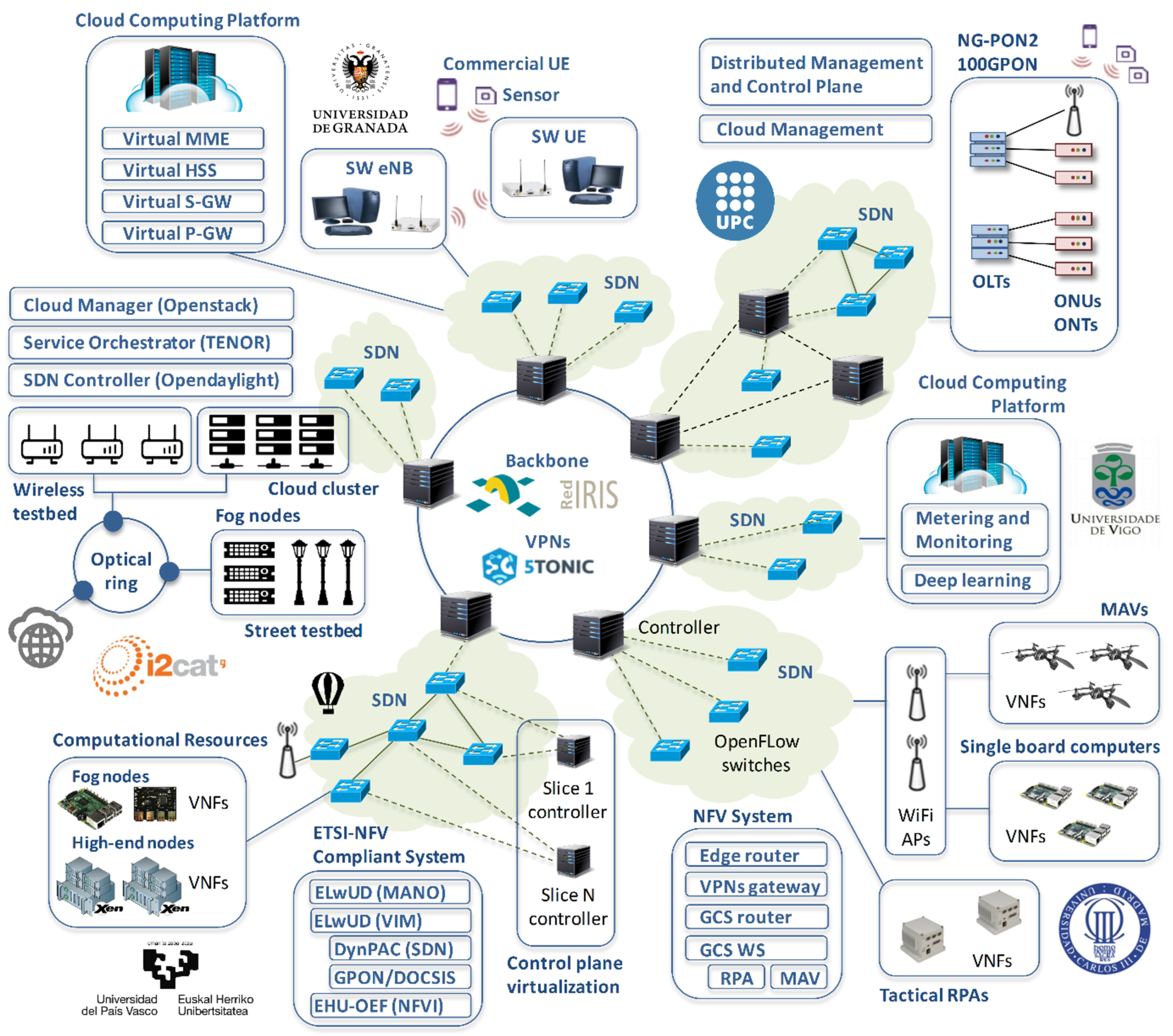Description
WiMuNet owns the following equipment:
- 5G network infrastructure
- 2 Amarisoft base stations (equivalent to Callbox Classic) and cores, with 4G/5G NSA/5G SA capabilities, in addition to VoLTE, LTE-M and NB-IoT
- Several NI USRPs (4xNI USRP 2901 (70 MHz to 6 GHz, BW 56 MHz) and 4xNI USRP 2953R (1.2 to 6 GHz, BW 120 MHz))
- 5G mobile phones (1xHuawei P40, 2xXiaomi 12) and 5G modems (1xQuectel RM500Q-GL and 2xQuectel RM500Q-AE)
- 30 Pycom FiPy nodes (LTE-M/NB-IoT capable, in addition to BLE/Wi-Fi/SigFox/LoRa&LoRaWAN)
- 10 programmable USIMs from sysmocom and USIM reader/writer
- RF shielded enclosure, aka Faraday cage (LBX1000 RF Shielded Test Enclosure)
- Access to the anechoic chamber at CITIC
- 4G/5G base stations, core and UEs based on USRPs with OpenAirInterface5G, srsRAN, free5GC and Open5GS
- Wi-Fi network infrastructure
- Xiaomi Mi Router AX9000 (MU-MIMO 4x4, 4KQAM, 160 MHz, max. data rate 4804 Mbps in the 5 GHz band, 4x1GbE + 1x2.5GbE)
- Xiaomi Mi Router AX3600 (MU-MIMO 4x4, 160 MHz, máx. data rate 2976 Mbps in the 5 GHz band, 4x1GbE)
- Intel AX201 Wi-Fi 6 cards (inside NUCs)
- D-LINK AX1800 USB cards (Wi-Fi 6 with 80 MHz and MU-MIMO 2x2)
- IoT network infrastructure
- Several LoRaWAN gateways (IMST Lite Gateway, Pycom PyGate)
- Many LoRaWAN nodes (Pycom FiPy (BLE, Wi-Fi, SigFox, LoRa/LoRaWAN, LTE-M/NB-IoT) with different expansion boards, Heltec LoRa32, TTGO LoRa32, TTGO T-Beam, LilyGO T-HiGrow with LoRa shield, custom nodes based on ESP8266/ESP32 with SX1278, ...)
- Many IoT sensors that can be added to our LoRaWAN nodes as needed
- LoRaWAN network and application servers (executable on servers or virtualized)
- BRESSER professional 7-in-1 Wi-Fi Weather Station
- SDN, TSN and other network infrastructure
- 1 switch AS4610-54T
- 2 switches NetGear M4300-28G stackable (24x1G, 2x10GBaseT, 2xSFP+, SDN)
- 2 switches TSN Z16 (WR-Z16 with 16 SFP connectors)
- 2 Intel E810-XXVDA2 NICs
- 18 GLC-SX-MM 1000BASE-SX transceptors
- 2 Intel E10GSFPSR 10GBASE-SX transceptors
- 1 switch Edgecore AS4610-54T
- Computing resources
- 2 servers HP Z4 I9-10920X 2X 1 TB 256 GB 2 XRTX3090
- 3 rack servers Supermicro SYS-6019U-TRTP2 (Intel Xeon 4110, RAM: 8x16 GB, 2x10G SFP+, 2x1GbE)
- 1 rack server HP SunFire X4150
- Several tower servers with Intel i7 / Intel Xeon CPUs and 16/32 GB of RAM
- Several Intel NUCs with i7 and 16/32 GB of RAM
- Several Raspberry Pi 4
- Vehicles and UAVs
- 4 TELLO drones (2 DJI ROBOMASTER TT TELLO TALENT and 2 DJI TELLO EDU)
- 2 AWS DeepRacer Evo equipped with stereo cameras and a LiDAR sensor
- 5G network infrastructure
- 2 Amarisoft base stations (equivalent to Callbox Classic) and cores, with 4G/5G NSA/5G SA capabilities, in addition to VoLTE, LTE-M and NB-IoT
- Several NI USRPs (4xNI USRP 2901 (70 MHz to 6 GHz, BW 56 MHz) and 4xNI USRP 2953R (1.2 to 6 GHz, BW 120 MHz))
- 5G mobile phones (1xHuawei P40, 2xXiaomi 12) and 5G modems (1xQuectel RM500Q-GL and 2xQuectel RM500Q-AE)
- 30 Pycom FiPy nodes (LTE-M/NB-IoT capable, in addition to BLE/Wi-Fi/SigFox/LoRa&LoRaWAN)
- 10 programmable USIMs from sysmocom and USIM reader/writer
- RF shielded enclosure, aka Faraday cage (LBX1000 RF Shielded Test Enclosure)
- Access to the anechoic chamber at CITIC
- 4G/5G base stations, core and UEs based on USRPs with OpenAirInterface5G, srsRAN, free5GC and Open5GS
- Wi-Fi network infrastructure
- Xiaomi Mi Router AX9000 (MU-MIMO 4x4, 4KQAM, 160 MHz, max. data rate 4804 Mbps in the 5 GHz band, 4x1GbE + 1x2.5GbE)
- Xiaomi Mi Router AX3600 (MU-MIMO 4x4, 160 MHz, máx. data rate 2976 Mbps in the 5 GHz band, 4x1GbE)
- Intel AX201 Wi-Fi 6 cards (inside NUCs)
- D-LINK AX1800 USB cards (Wi-Fi 6 with 80 MHz and MU-MIMO 2x2)
- IoT network infrastructure
- Several LoRaWAN gateways (IMST Lite Gateway, Pycom PyGate)
- Many LoRaWAN nodes (Pycom FiPy (BLE, Wi-Fi, SigFox, LoRa/LoRaWAN, LTE-M/NB-IoT) with different expansion boards, Heltec LoRa32, TTGO LoRa32, TTGO T-Beam, LilyGO T-HiGrow with LoRa shield, custom nodes based on ESP8266/ESP32 with SX1278, ...)
- Many IoT sensors that can be added to our LoRaWAN nodes as needed
- LoRaWAN network and application servers (executable on servers or virtualized)
- BRESSER professional 7-in-1 Wi-Fi Weather Station
- SDN, TSN and other network infrastructure
- 1 switch AS4610-54T
- 2 switches NetGear M4300-28G stackable (24x1G, 2x10GBaseT, 2xSFP+, SDN)
- 2 switches TSN Z16 (WR-Z16 with 16 SFP connectors)
- 2 Intel E810-XXVDA2 NICs
- 18 GLC-SX-MM 1000BASE-SX transceptors
- 2 Intel E10GSFPSR 10GBASE-SX transceptors
- 1 switch Edgecore AS4610-54T
- Computing resources
- 2 servers HP Z4 I9-10920X 2X 1 TB 256 GB 2 XRTX3090
- 3 rack servers Supermicro SYS-6019U-TRTP2 (Intel Xeon 4110, RAM: 8x16 GB, 2x10G SFP+, 2x1GbE)
- 1 rack server HP SunFire X4150
- Several tower servers with Intel i7 / Intel Xeon CPUs and 16/32 GB of RAM
- Several Intel NUCs with i7 and 16/32 GB of RAM
- Several Raspberry Pi 4
- Vehicles and UAVs
- 4 TELLO drones (2 DJI ROBOMASTER TT TELLO TALENT and 2 DJI TELLO EDU)
- 2 AWS DeepRacer Evo equipped with stereo cameras and a LiDAR sensor
Mobile networks
PoC based on Amarisoft equipment/software
The following pictures show an example of an Amarisoft scenario with 5G SA, MIMO 2x2, 50 MHz in the n78 band (TDD). The Quectel RM500Q-AE modem is able to achieve more than 350 Mbps (downlink). Private repository here.
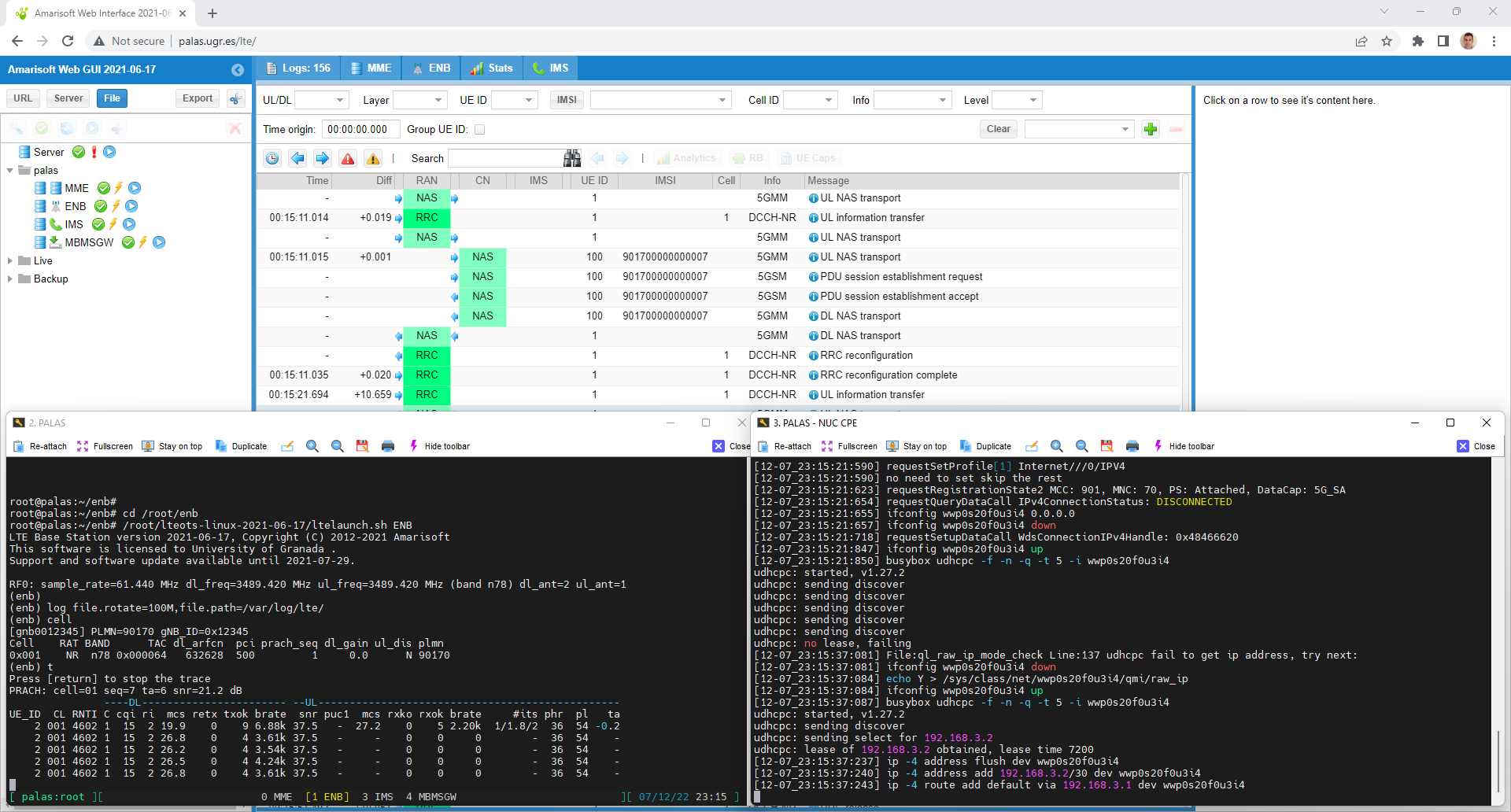



PoC based on srsRAN platform
This testbed employs an Ettus B210 (NI USRP 2901) connected to an Intel NUC. UE is a Quectel RM500Q-GL modem connected to another Intel NUC. It supports 4G, 5G NSA (with srsEPC) and 5G SA (with Open5GS) with both real equipment and virtual hardware (ZMQ virtual radios). Private repository here.
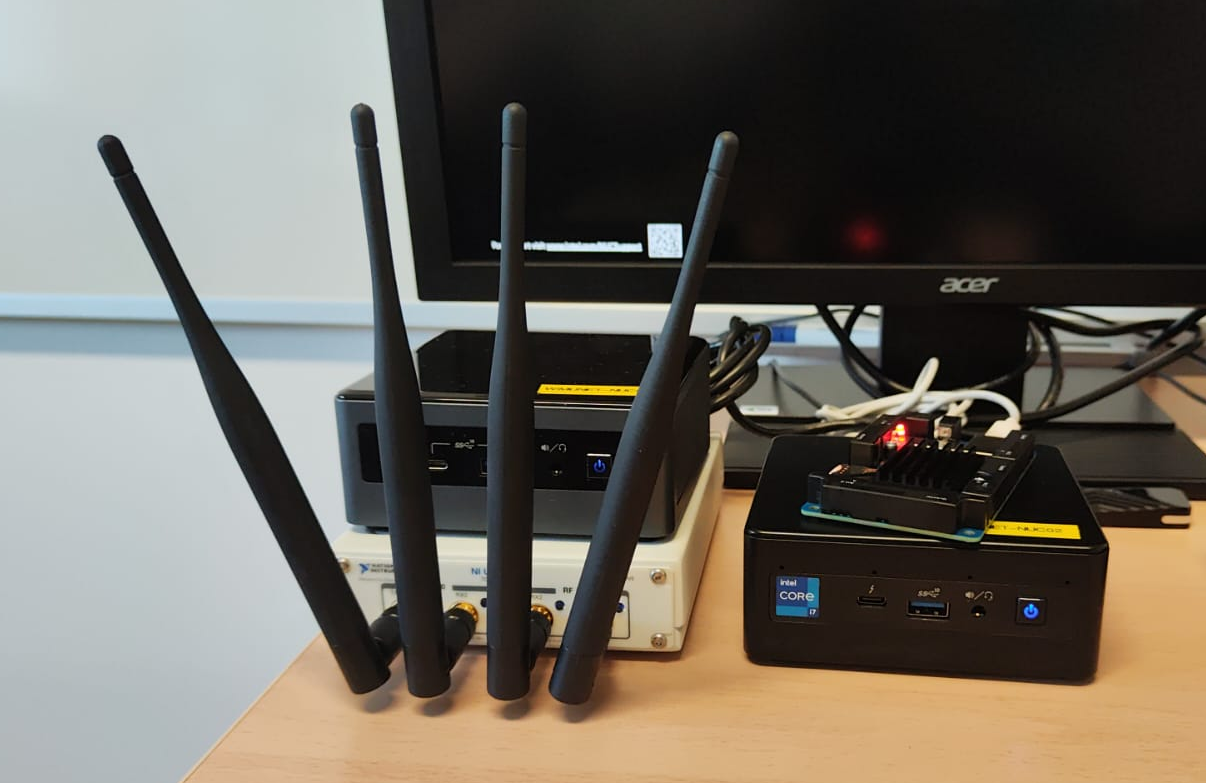
Also supporting 4G with a Raspberry Pi 4 (low bandwidth). Private repository here.
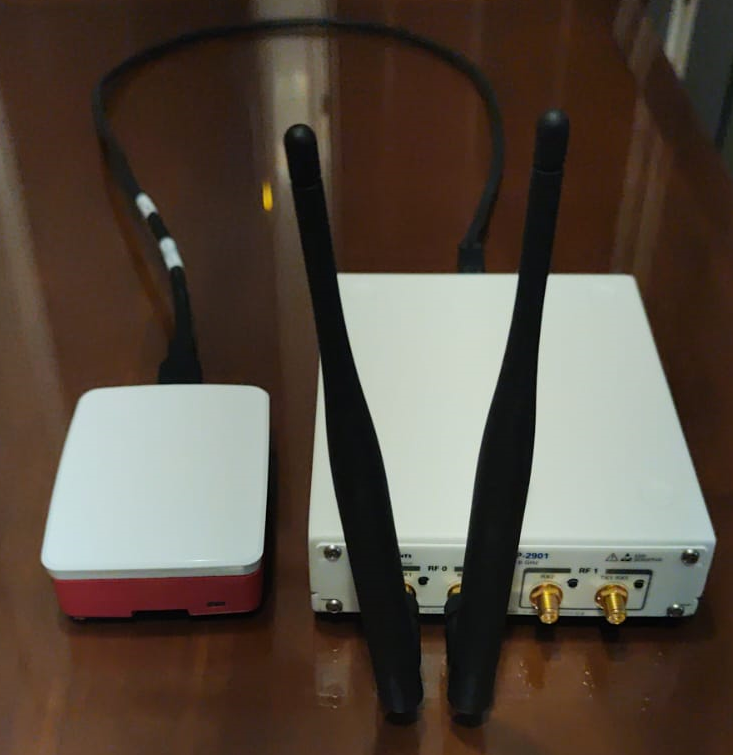


Multi-connectivity
Multi-connectivity demonstrator using real equipment
This testbed is part of our work for the 5G-CLARITY European project. To be published.
The following picture presents the topology of our multi-connectivity testbeds, including a 5G network, a Wi-Fi 6 network, and the required MPTCP entities.
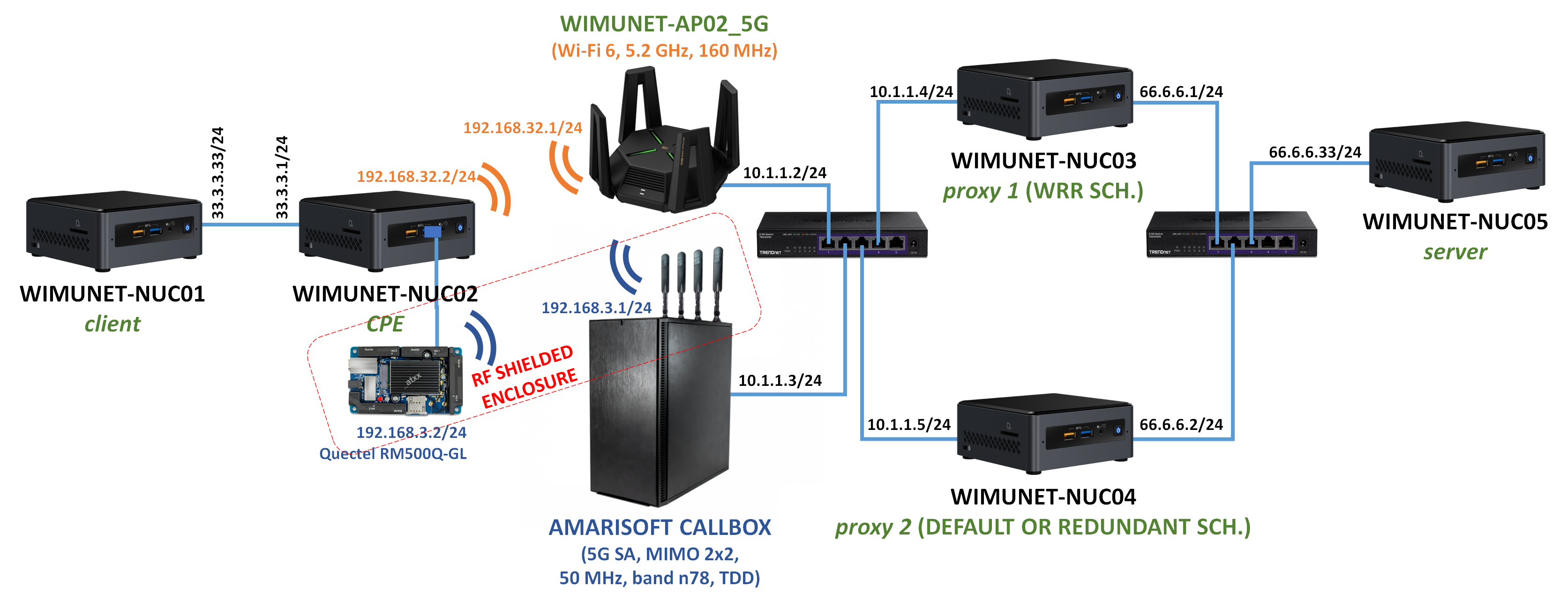
The following picture shows our demonstrator.
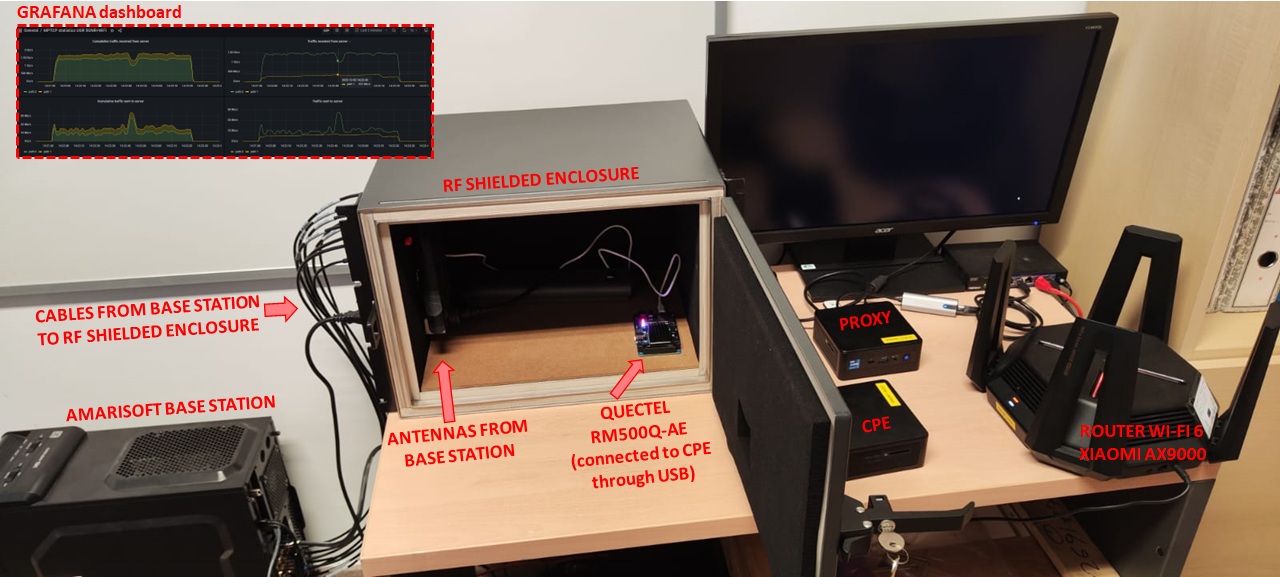
Multi-connectivity virtual testbed
Multi-connectivity virtual testbed (used e.g. for the 5G-CLARITY European Project). Available here.
The following picture summarizes one of the scenarios, where the CPE (VM mptcpUe) is connected using 3 network interfaces (5G NR, Wi-Fi and Li-Fi) to the MPTCP proxy (VM mptcpProxy) through the Non-3GPP Interworking Function (N3IWF) of a 5G Core Network (implemented using free5gc).
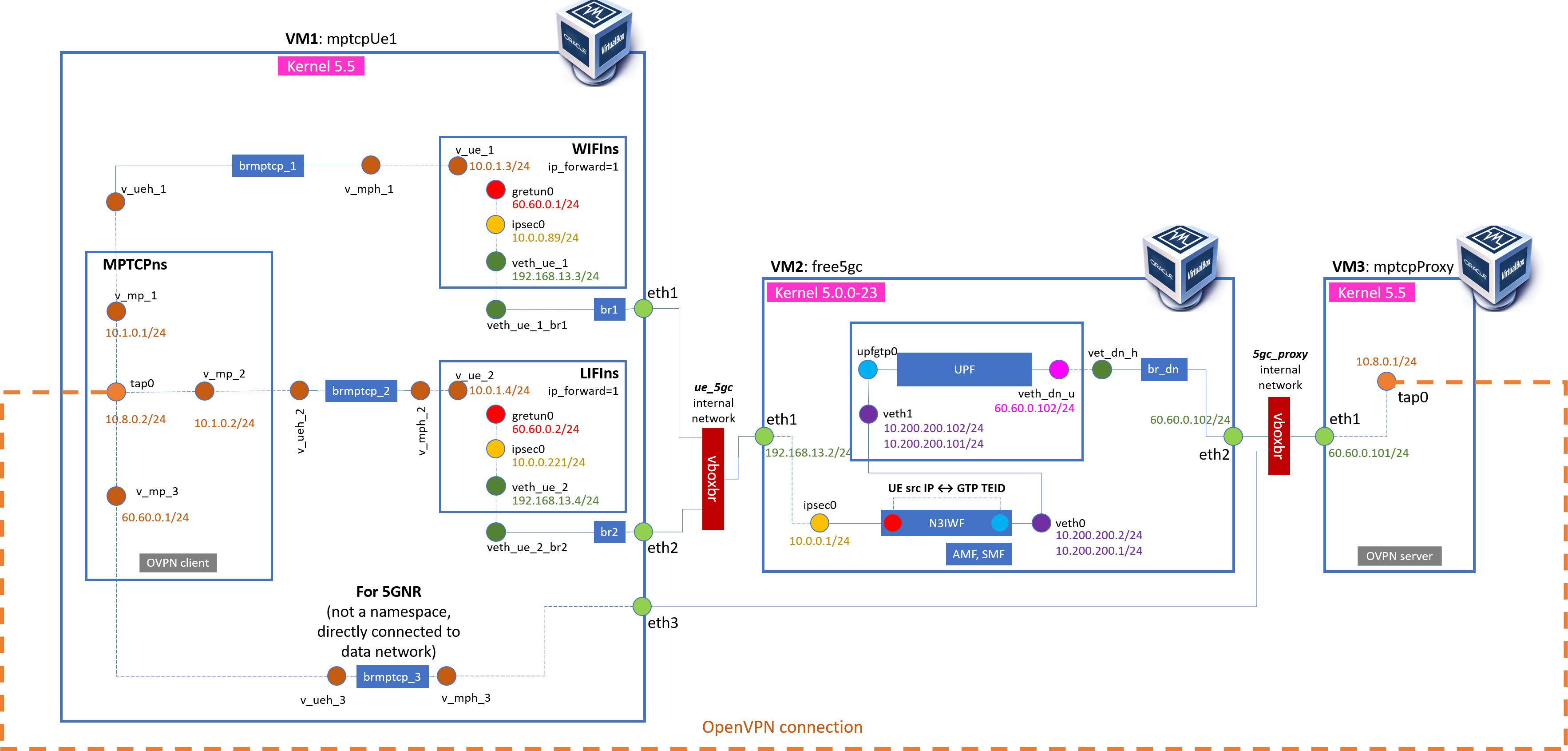
The following picture summarizes another scenario, where the CPE is connected to several MPTCP proxies. The CPE acts as a switch (using OVS) for all the clients that may be connected, and uses different VLAN IDs to route the packets to the server through the different proxies (one VLAN per proxy).
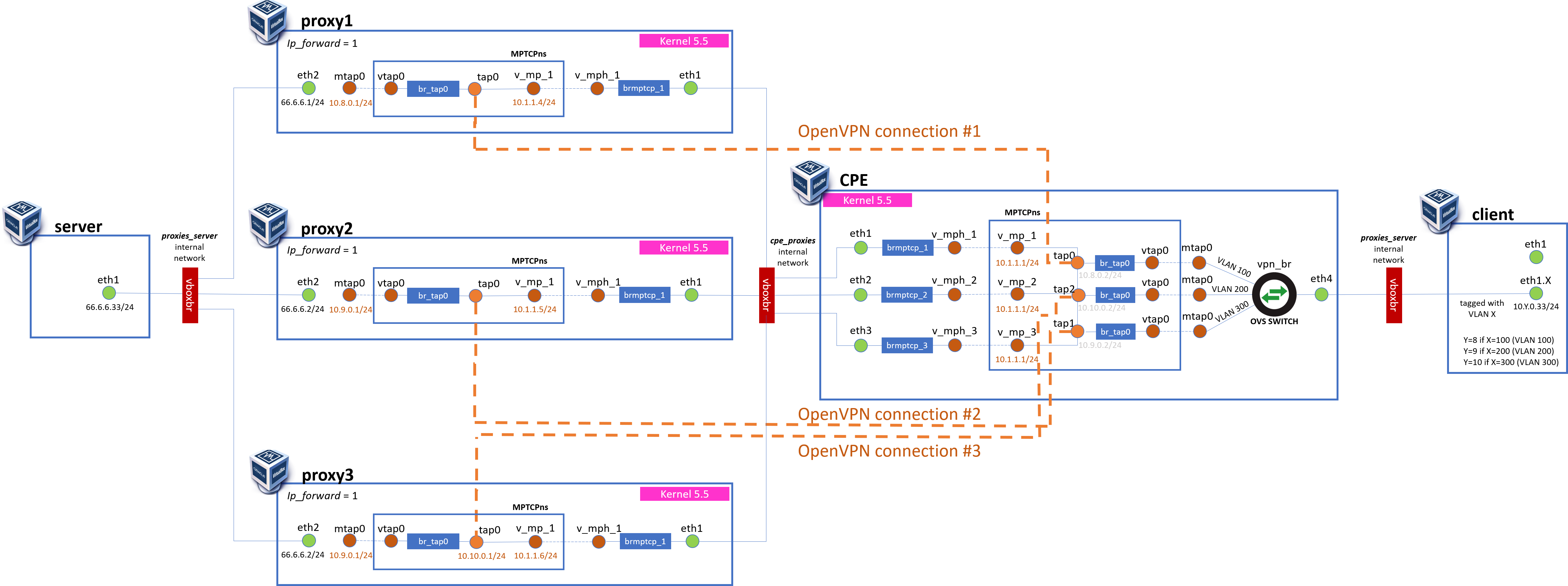
You can check the following video with the execution of this testbed. Available here.


IoT
Basic LoRaWAN testbed
This basic LoRaWAN testbed is included in a private repository here.
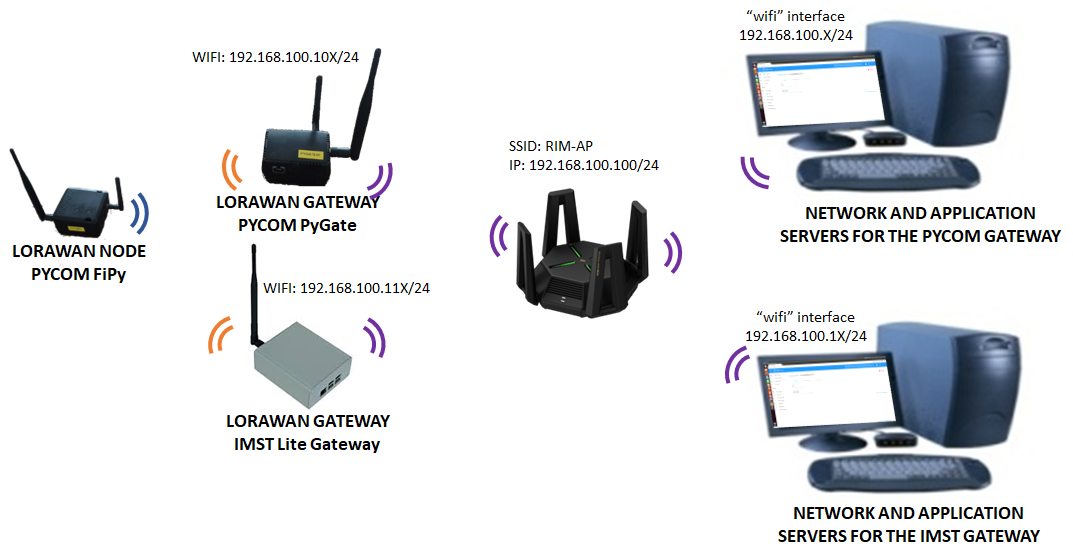
Public repositories including sample firmware for different devices:
- Repository for TTGO LoRa32 here
- Repository for TTGO T-Beam Tracker here
- Repository for LilyGO T-HiGrow + T-HiGrow Lora Sheld here
- Repository for LilyGO T-HiGrow with Wi-Fi here
Demonstrator for LoRaWAN network slicing
To be added soon (once it is published).
PoC to improve LoRaWAN network capacity (for the paper "Collision Avoidance Resource Allocation for LoRaWAN")
Testbed using LoRaWAN gateways and nodes to implement the solution to reduce collisions (i.e. increase LoRaWAN network capacity) in our paper "Collision Avoidance Resource Allocation for LoRaWAN". Micropython code for Pycom's FiPy, to implement the device's part, available here. The following picture presents the testbed.
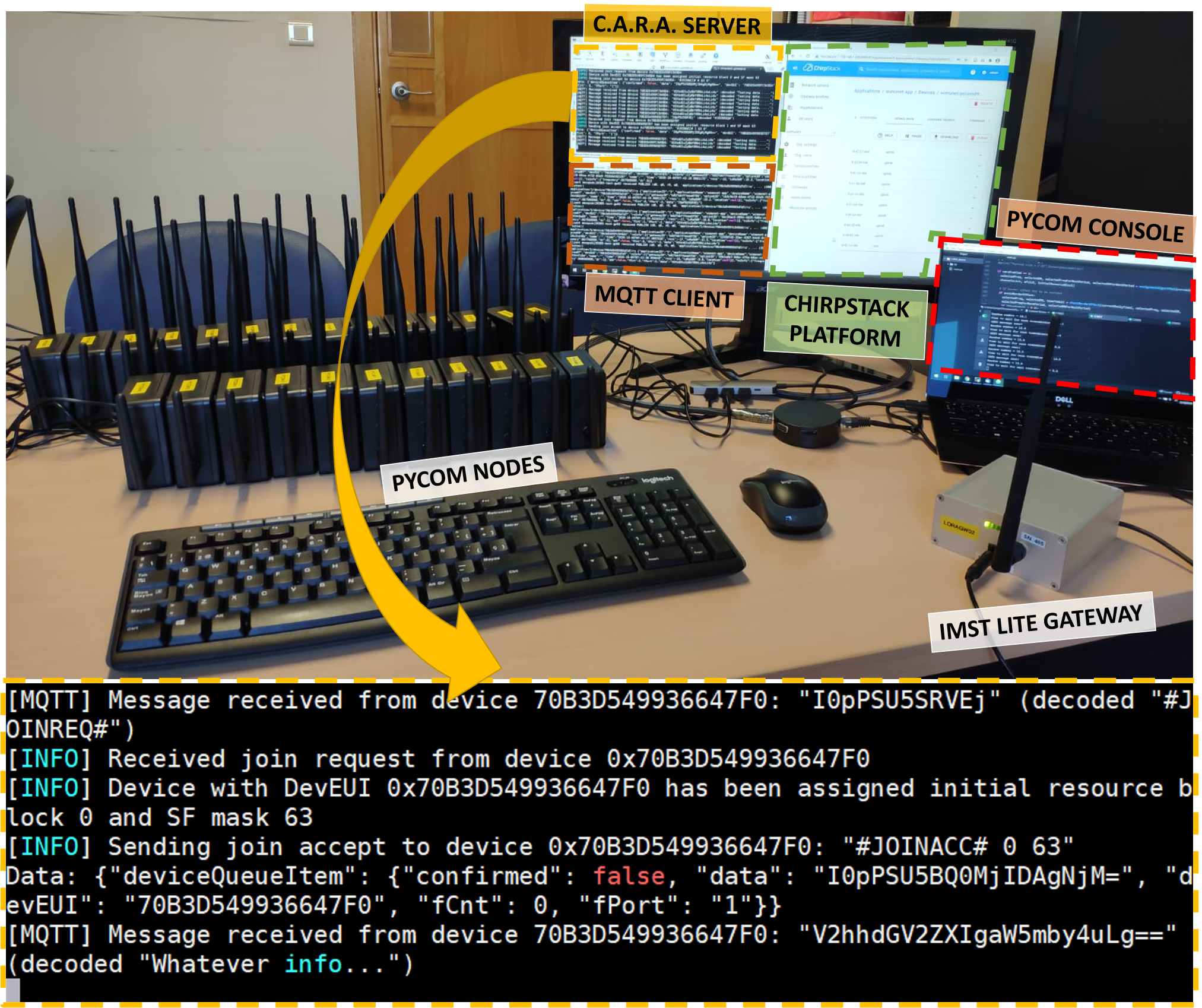
IoT network architecture demonstrator
Testbed using LoRaWAN gateways and nodes, connected to an SDN network that implements the solution to reduce MQTT traffic using multicast in our paper "A LoRaWAN Network Architecture with MQTT2MULTICAST". Implementation of the SDN network and the MQTT2MULTICAST protocol available here. The following picture summarizes the proposed architecture.
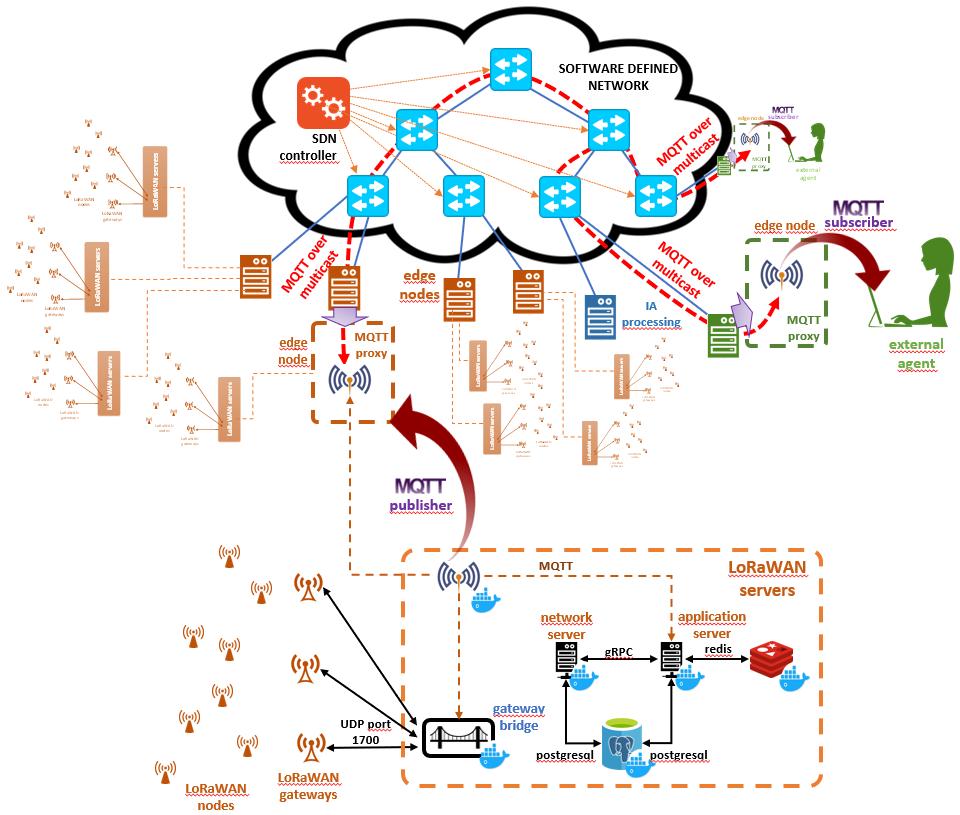
The following picture presents our proof-of-concept for the proposed network architecture.
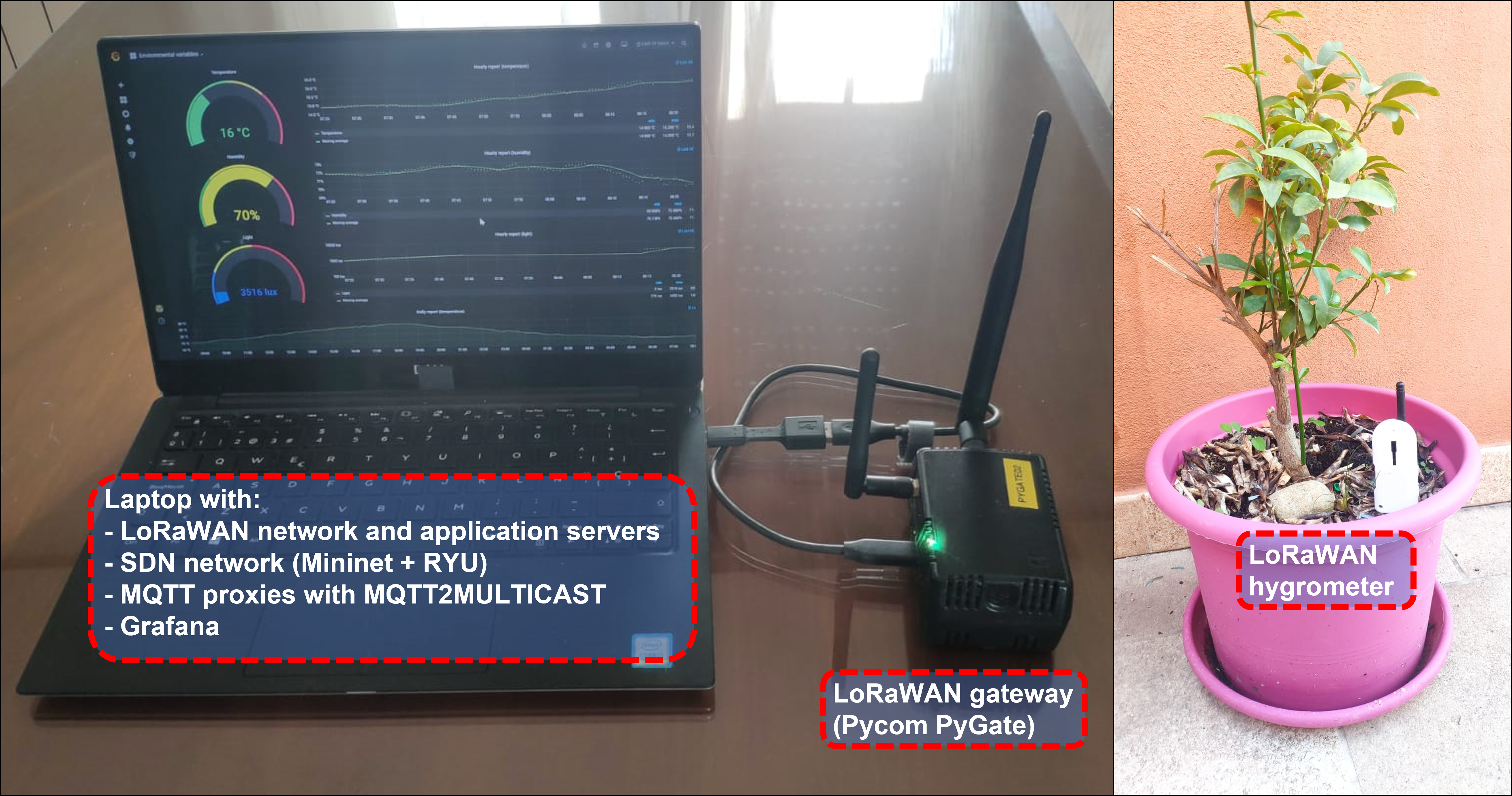
PoC for multimedia transmission over LoRa
Solution to implement a contention mechanism in order to increase the data rate and thus being able to send images over LoRa. In this testbed, a sender takes a picture from a camera and from an SD card and sends it over LoRa to a receiver, which in turn sends it over Wi-Fi to a streaming server. This allows to send low-resolution images or low-quality videos over LoRa devices, which may be useful in many situations. Current tests show that an image of 10KB can be sent in around 4-6 seconds without contention and around 10-12 seconds with contention. The repository with the code will be made available here once this work is published. The following picture presents the testbed. You can check how the testbed works on the following videos, using contention here and without contention here.
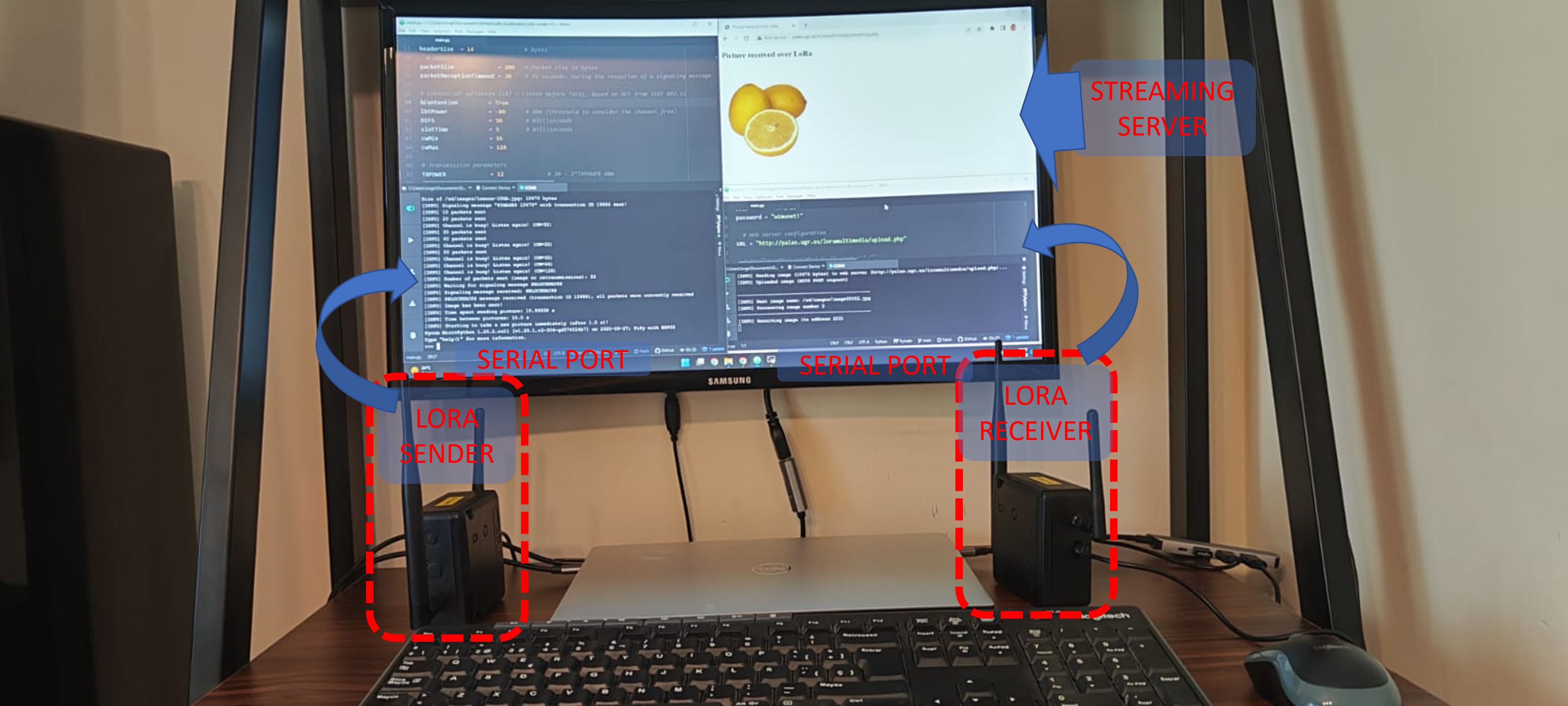
Demonstrator for a LoRaWAN network supporting critical situations
Testbed that implements the solution in our paper "A LoRaWAN Testbed Design for Supporting Critical Situations: Prototype and Evaluation". This testbed is able to automatically recover if part of its network infrastructure is destroyed, e.g. after an earthquake. We implement the core network functionalities on top of a Kubernetes cluster (using containers) and also using OpenStack (using virtual machines) for comparison purposes.
The following pictures present our proof-of-concept for the proposed network architecture using real equipment (TTGO LoRa32 nodes and IMST Lite gateways) for the radio access network.
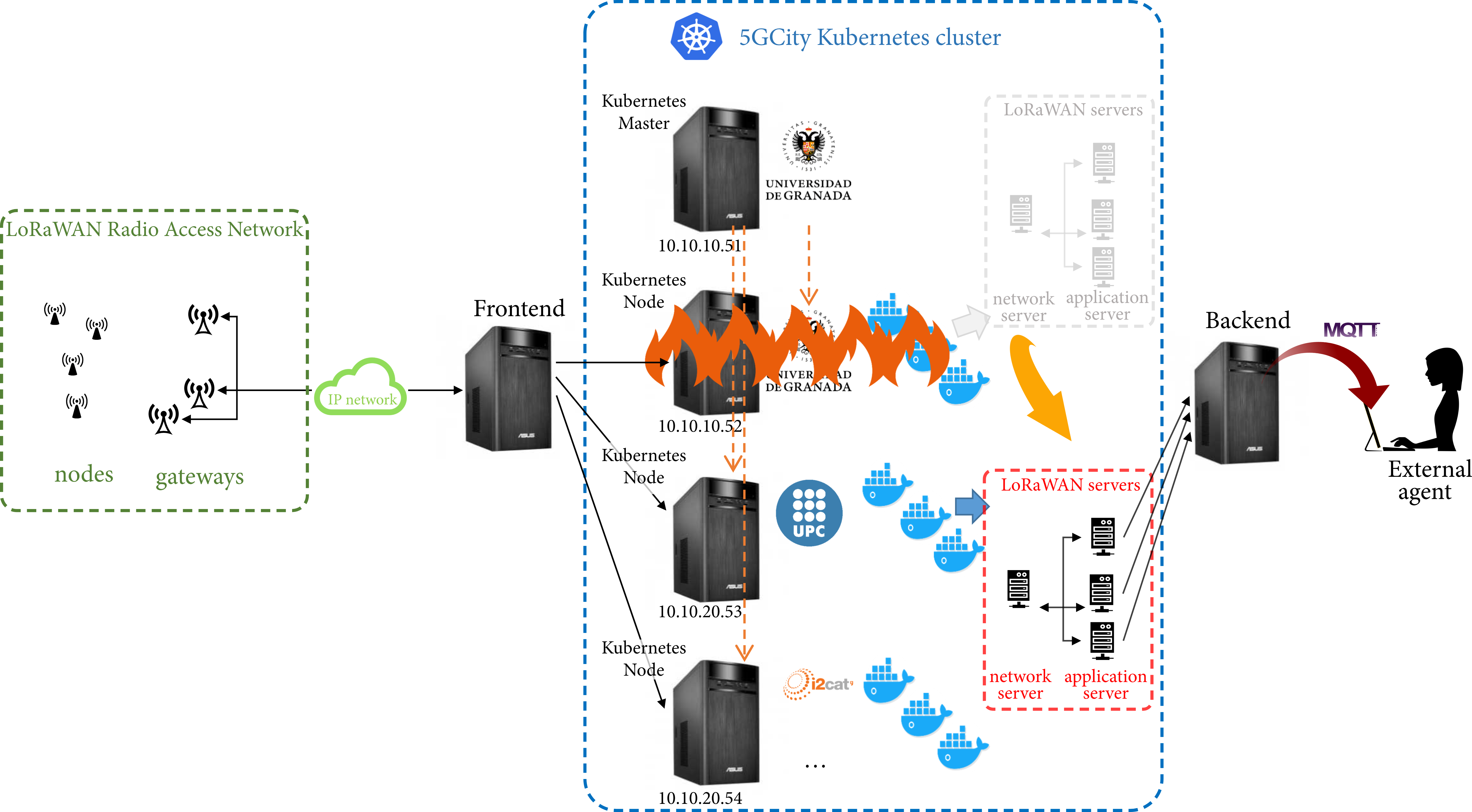
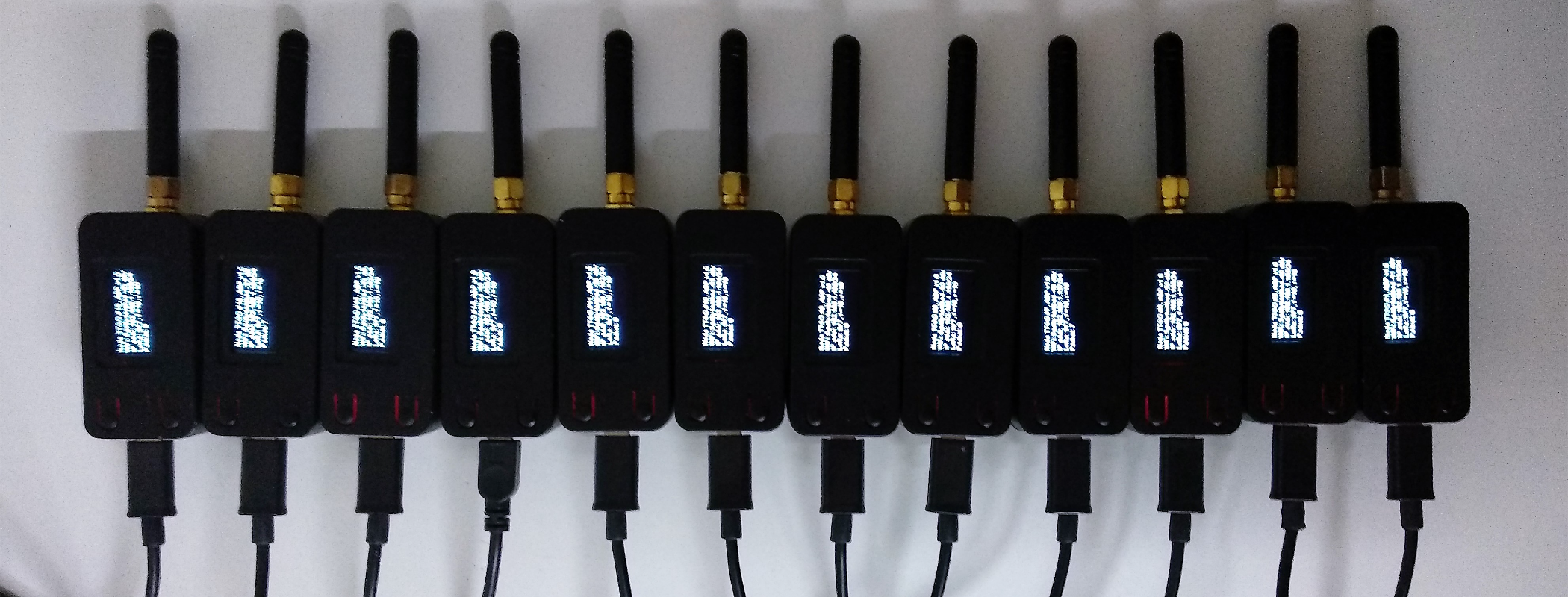
Weather station at the School of Informatics and Telecommunications Engineering
We have deployed a weather station from Bresser (BRESSER professional 7-in-1 Wi-Fi Weather Station) which will allow us to get environmental data (temperature, humidity, barometric pressure, wind speed and orientation, precipitation rate, UV level and light intensity) and to generate real traffic. It transmits data via 868 MHz to the base station, which stores historical local weather data shown in its display. The data sent via 868 MHz can be easily forwarded using LoRaWAN thus converting it in a LoRaWAN-enabled weather station, which can be used in our testbeds to generate LoRaWAN traffic using realistic data.
The following pictures present our weather station. Historical data is available at Weather Underground, Weather Cloud and AWEKAS.
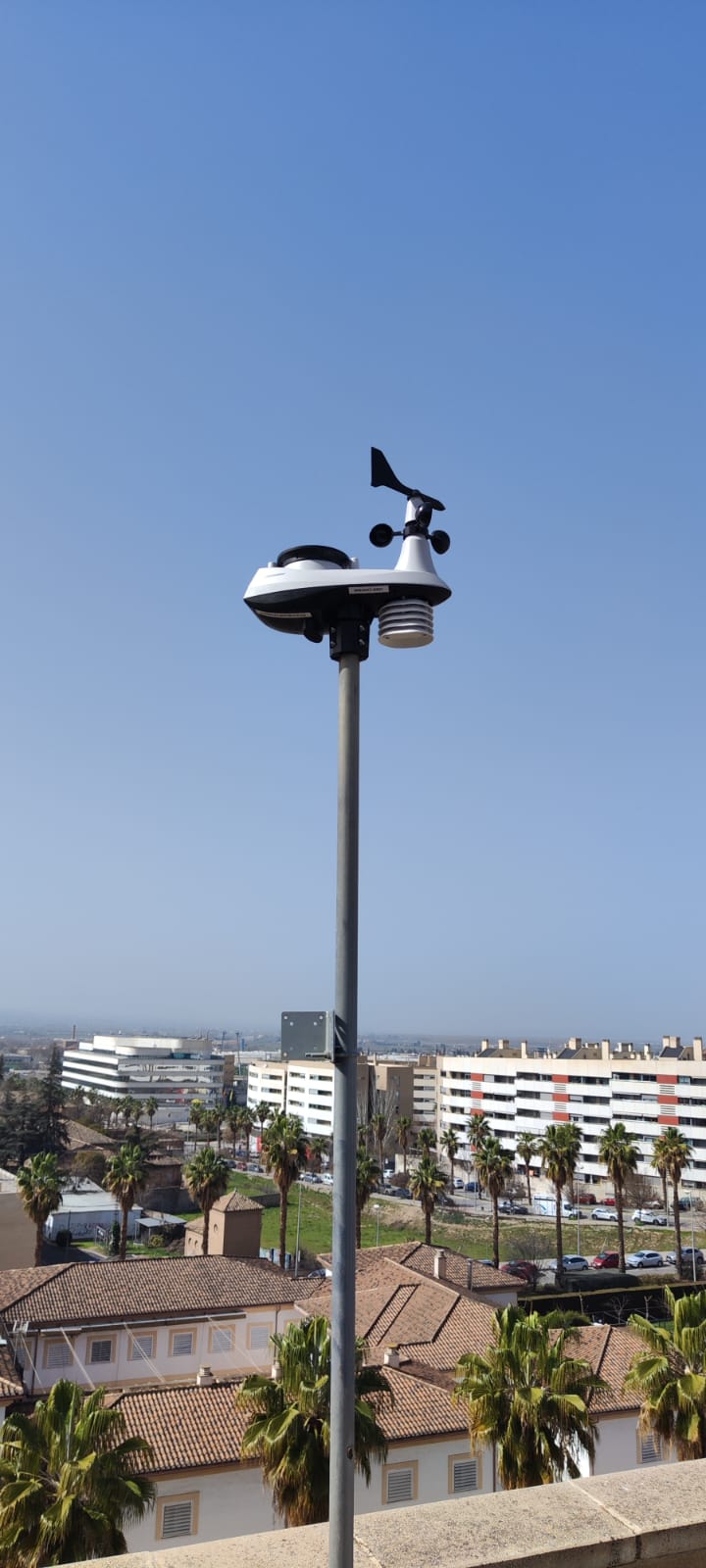
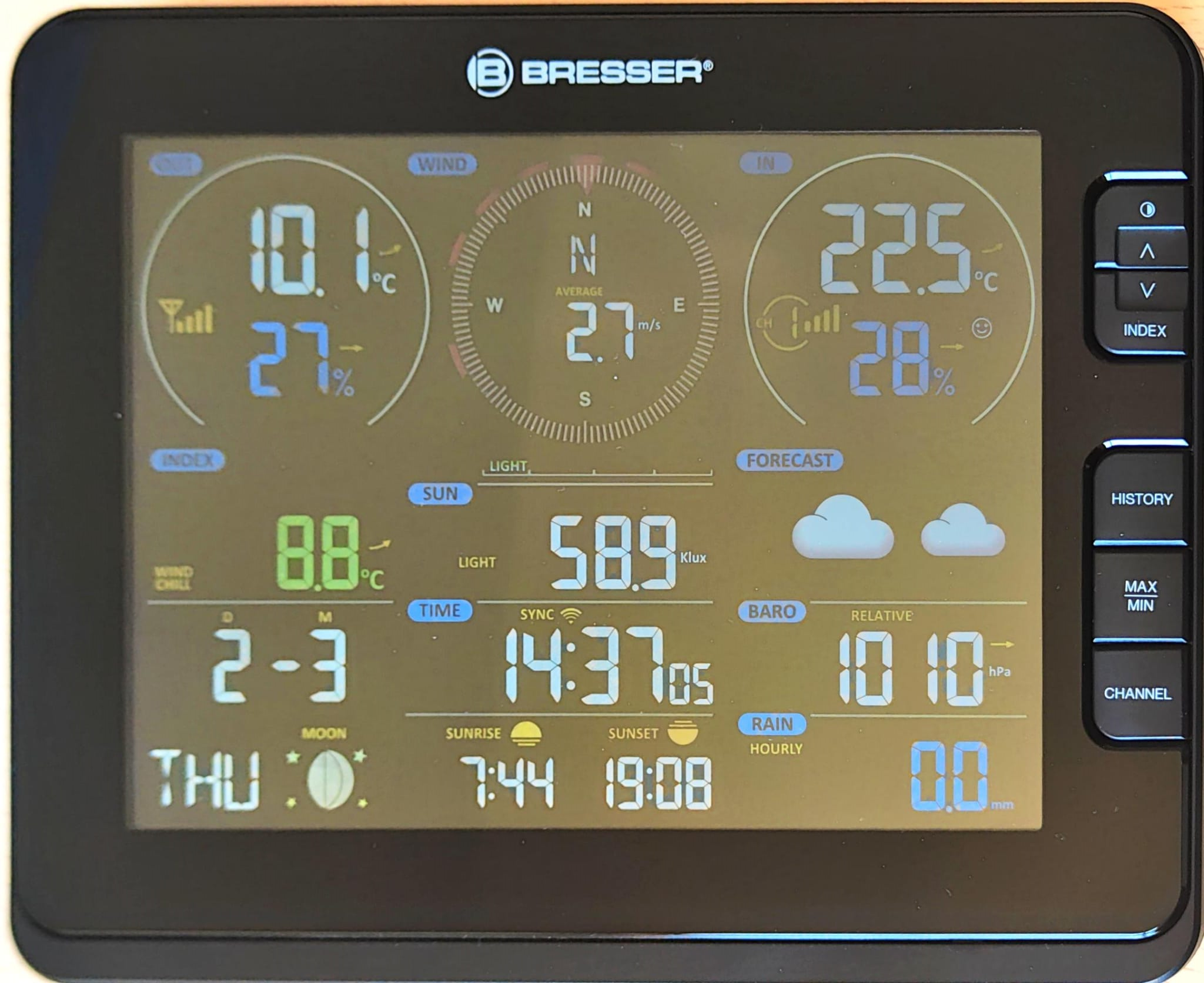
We have converted this weather station onto a LoRaWAN-enabled device by using an ESP32 as a gateway between 868 MHz (FSK) and LoRaWAN. The first step was to include a Bresser 7-in-1 decoder in the BresserWeatherSensorReceiver Arduino library. The second step was to include program a LoRaWAN device (a Heltec Wireless Stick) to receive weather information via 868 MHz and then sending that information (using Cayenne LPP encoding) to a LoRaWAN network (TTN or our LoRaWAN testbed). This work is included in a private repository. The following picture shows the logs (from the serial monitor in Arduino) and the data received in The Things Networks.
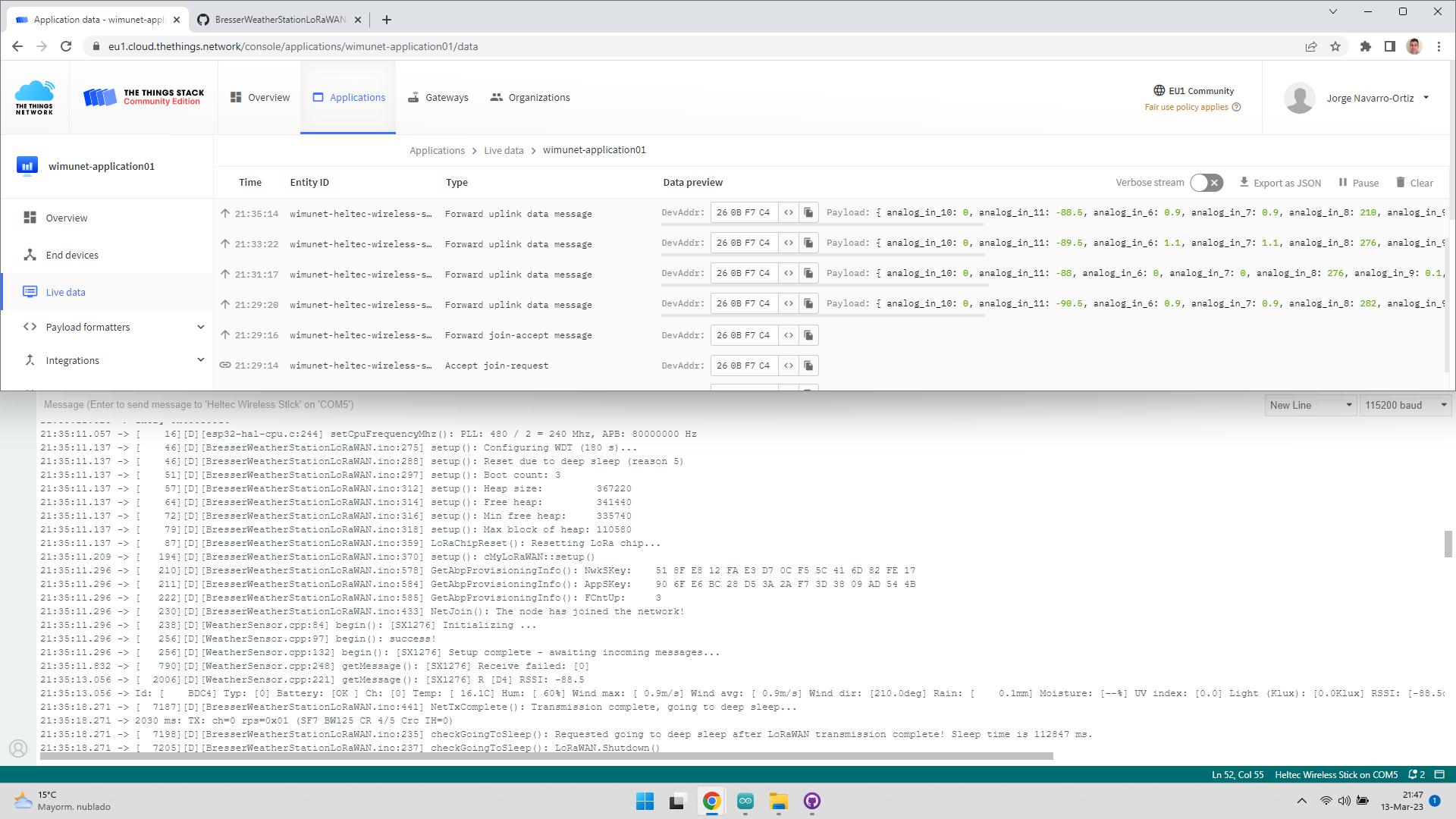
We have also created a platform to show graphs with the weather station data. Since the weather station transmits these data to TTN using LoRaWAN, which in turn publishes the measurements using MQTT, our platform acts as a gateway between MQTT and an InfluxDB database, whose data is finally shown using a Grafana dashboard. This platform is available at a private repository. The following picture shows an example of this Grafana dashboard (including temperature, humidity, wind, rain, UV and light data, in addition to SNR, RSSI and battery information).
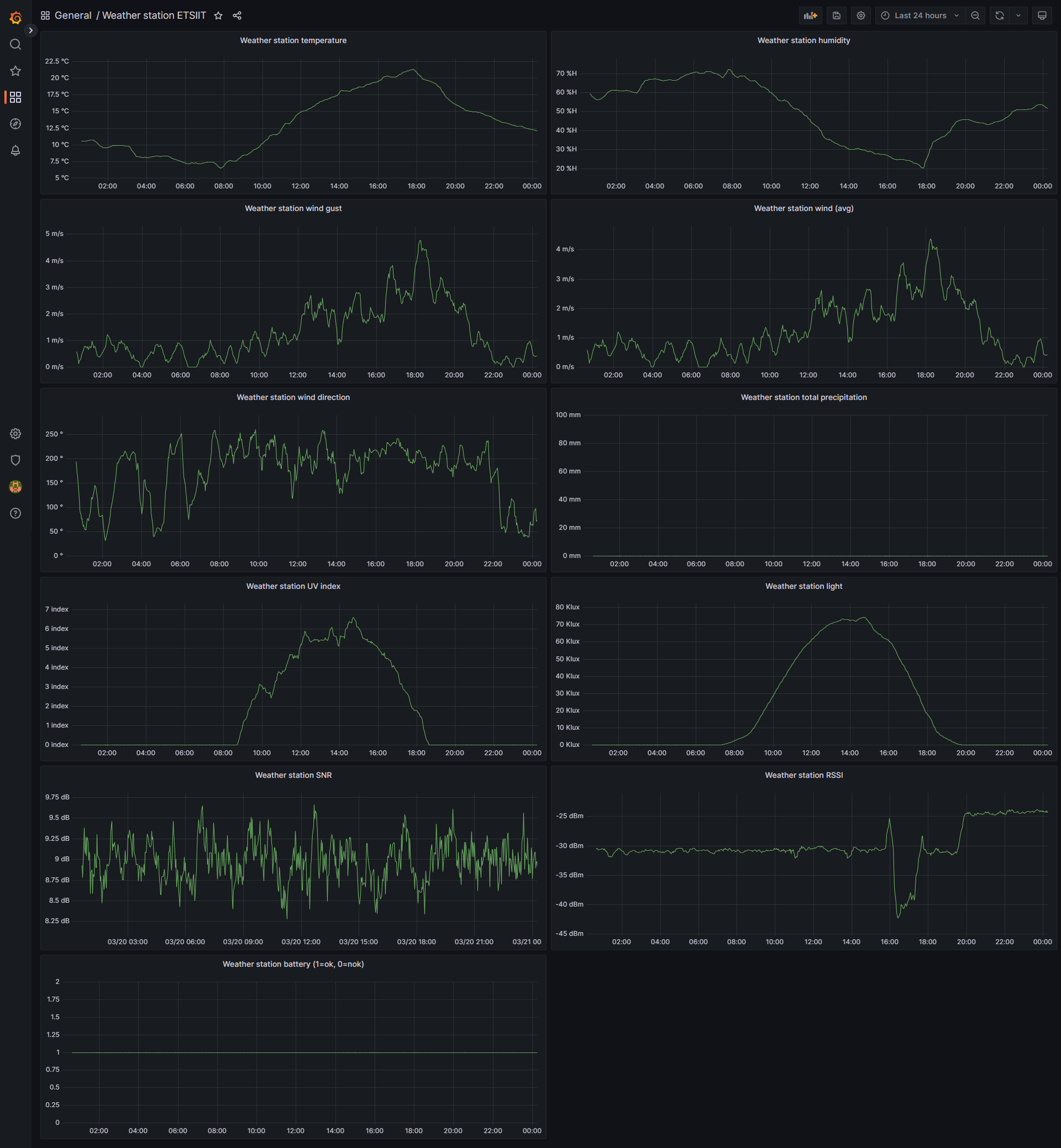

-
To be added soon (once it is published).
-
Testbed using LoRaWAN gateways and nodes to implement the solution to reduce collisions (i.e. increase LoRaWAN network capacity) in our paper "Collision Avoidance Resource Allocation for LoRaWAN". Micropython code for Pycom's FiPy, to implement the device's part, available here. The following picture presents the testbed.

-
Testbed using LoRaWAN gateways and nodes, connected to an SDN network that implements the solution to reduce MQTT traffic using multicast in our paper "A LoRaWAN Network Architecture with MQTT2MULTICAST". Implementation of the SDN network and the MQTT2MULTICAST protocol available here. The following picture summarizes the proposed architecture.

-
The following picture presents our proof-of-concept for the proposed network architecture.

-
Solution to implement a contention mechanism in order to increase the data rate and thus being able to send images over LoRa. In this testbed, a sender takes a picture from a camera and from an SD card and sends it over LoRa to a receiver, which in turn sends it over Wi-Fi to a streaming server. This allows to send low-resolution images or low-quality videos over LoRa devices, which may be useful in many situations. Current tests show that an image of 10KB can be sent in around 4-6 seconds without contention and around 10-12 seconds with contention. The repository with the code will be made available here once this work is published. The following picture presents the testbed. You can check how the testbed works on the following videos, using contention here and without contention here.

-
Testbed that implements the solution in our paper "A LoRaWAN Testbed Design for Supporting Critical Situations: Prototype and Evaluation". This testbed is able to automatically recover if part of its network infrastructure is destroyed, e.g. after an earthquake. We implement the core network functionalities on top of a Kubernetes cluster (using containers) and also using OpenStack (using virtual machines) for comparison purposes.
-
The following pictures present our proof-of-concept for the proposed network architecture using real equipment (TTGO LoRa32 nodes and IMST Lite gateways) for the radio access network.


-
We have deployed a weather station from Bresser (BRESSER professional 7-in-1 Wi-Fi Weather Station) which will allow us to get environmental data (temperature, humidity, barometric pressure, wind speed and orientation, precipitation rate, UV level and light intensity) and to generate real traffic. It transmits data via 868 MHz to the base station, which stores historical local weather data shown in its display. The data sent via 868 MHz can be easily forwarded using LoRaWAN thus converting it in a LoRaWAN-enabled weather station, which can be used in our testbeds to generate LoRaWAN traffic using realistic data.
-
The following pictures present our weather station. Historical data is available at Weather Underground, Weather Cloud and AWEKAS.


-
We have converted this weather station onto a LoRaWAN-enabled device by using an ESP32 as a gateway between 868 MHz (FSK) and LoRaWAN. The first step was to include a Bresser 7-in-1 decoder in the BresserWeatherSensorReceiver Arduino library. The second step was to include program a LoRaWAN device (a Heltec Wireless Stick) to receive weather information via 868 MHz and then sending that information (using Cayenne LPP encoding) to a LoRaWAN network (TTN or our LoRaWAN testbed). This work is included in a private repository. The following picture shows the logs (from the serial monitor in Arduino) and the data received in The Things Networks.

-
We have also created a platform to show graphs with the weather station data. Since the weather station transmits these data to TTN using LoRaWAN, which in turn publishes the measurements using MQTT, our platform acts as a gateway between MQTT and an InfluxDB database, whose data is finally shown using a Grafana dashboard. This platform is available at a private repository. The following picture shows an example of this Grafana dashboard (including temperature, humidity, wind, rain, UV and light data, in addition to SNR, RSSI and battery information).

TSN networks
Demonstrator for TSN
The following picture shows our initial testing for our TSN network demonstrator. [UNDER CONSTRUCTION]
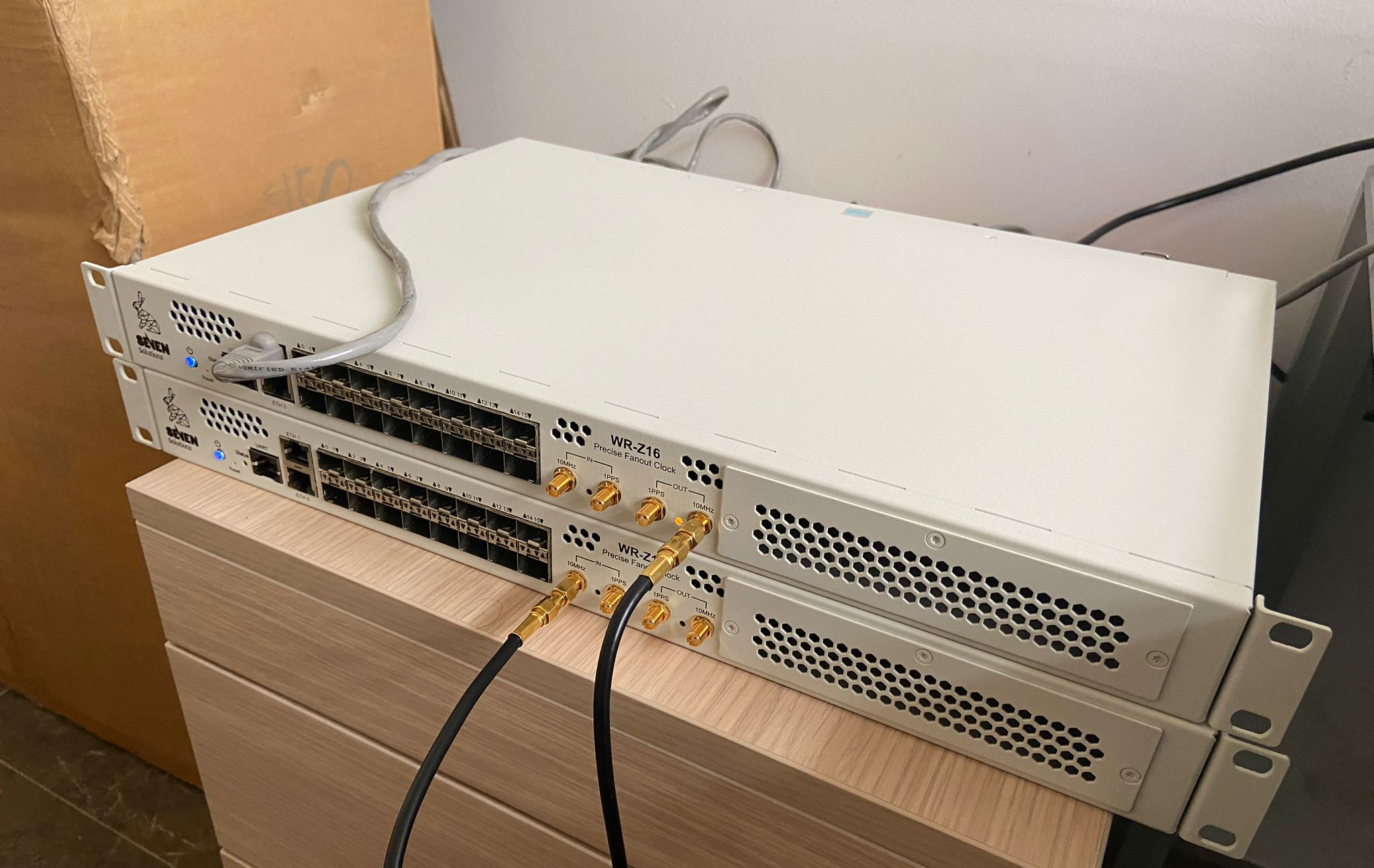

Vehicles and UAVs
UAVs for demonstrators
This picture shows one of our DJI TELLO drones, which will be used for demonstrators (e.g. to test LoRaWAN to send pictures over the air, or real-time services over mobile networks).
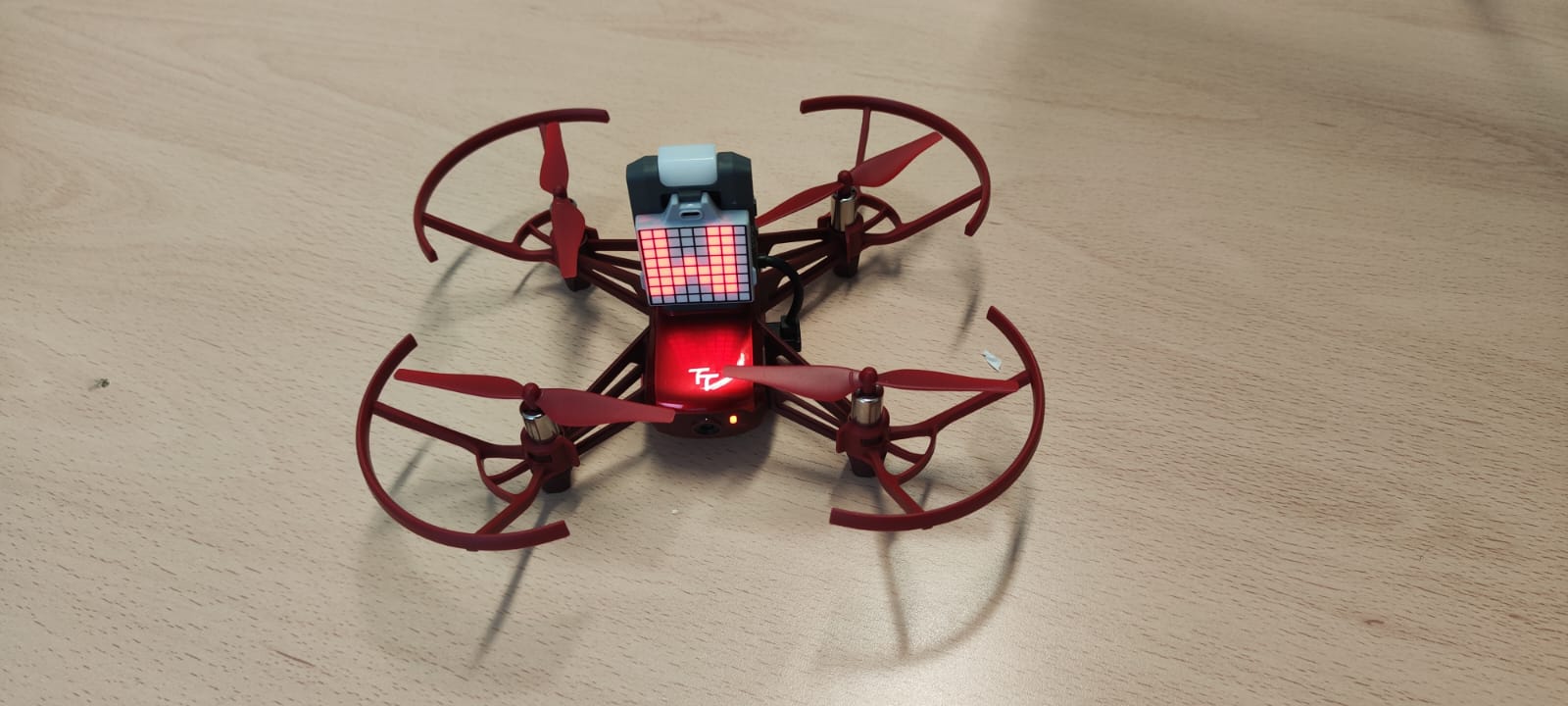
This picture shows one of our AWS DeepRacer Evo with stereo cameras and a LiDAR sensor, which will be used for demonstrators (e.g. to test LoRaWAN to send its location, or to send environmental information via LoRaWAN).
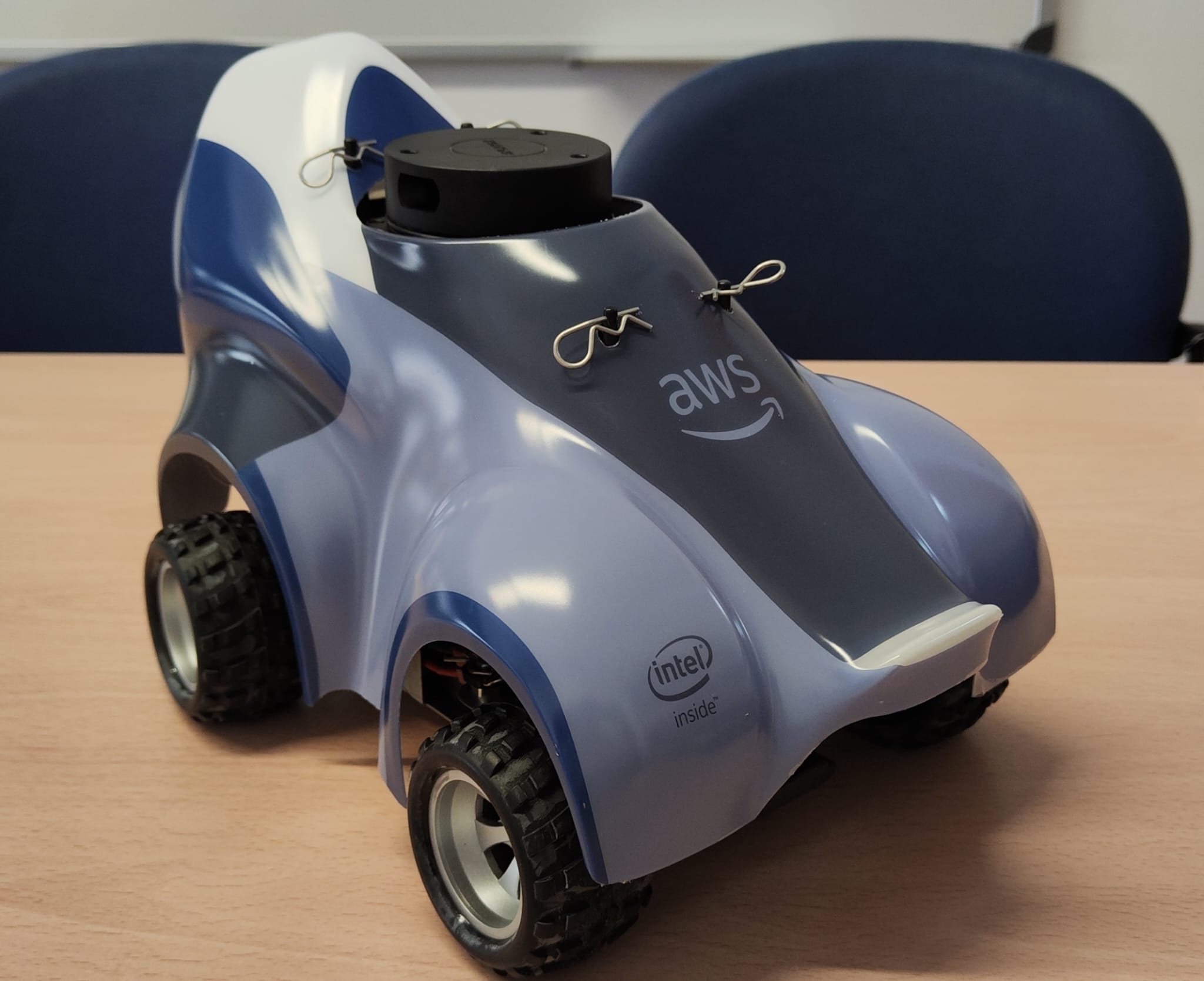


Testbeds with partners
Testbed for the 5G-CITY project
This picture shows our testbed with the partners from the 5G-CITY project. The different isles were connected using OpenVPN, which allowed us to have L2 connectivity. With this testbed, UGR contributed to two SDN-related papers ("An architecture for the 5G control plane based on SDN and data distribution service" and "The Roll of Data Distribution Service in Failure-aware SDN Controllers") and one LoRaWAN-related paper ("A LoRaWAN Testbed Design for Supporting Critical Situations: Prototype and Evaluation"), in addition to other experiments.
